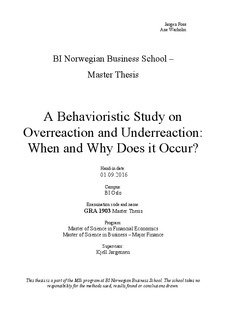| dc.description.abstract | The following thesis is a study of two related concepts known as “Overreaction”
and “Underreaction”. Overreaction and underreaction, both of which have been
offered by behaviorists as possible explanations to asset mispricing, provides a
more comprehensible framework for empirical work, than merely studying all
investor anomalies. As research on these phenomena’s in Norway has been fairly
scarce, we first make use of different models in order to prove their presence in
the Norwegian Stock Market. Collecting returns from all non-financial firms
listed on Oslo Stock Exchange from the period of 1999-2014, we explore whether
there are negative serial autocorrelation in the long run (24 months) and positive
autocorrelation in returns in the short run (6 months). Next, the findings are riskadjusted
and tested for robustness in order to assess whether these findings are in
fact due to overreaction and underreaction by investors. Finally, we compare and
review the existing literature on the two phenomena´s occurrence in the market: to
qualitatively assess when and why they might occur. Our findings seem to be in support of the Overreaction Hypothesis: both
non-adjusted and risk-adjusted abnormal returns on Norwegian data seem to be
too extreme to accord with market efficiency. While some results lack statistical
significance, our general findings are in congruence with the main consensus
within recent academia. As for underreaction, however, we did not find evidence
of positive serial autocorrelation in the short term on our specific sample.
Reviewing a broad collection of related literature, we argue that overreaction
occurs prior to portfolio formation, while underreaction occurs after. Put simply,
investors overreact to future news announcements and thus drive the price of
growth stocks too high and the price of value stocks too low. After portfolio
formation, on the other hand, investors underreact to news that contradicts their
prior and embedded beliefs. Finally, we hypothesize that overreaction is best
explained by the Representativeness Heuristic, which means that investors
perceive past performance to be representative for the future, ignoring some of the
fundamental aspects. Lastly, we believe that underreaction is a result of a
cognitive bias known as the Conservatism Bias. And to avoid the negative
psychological repercussions of changing an embedded belief, underreaction is
also a result of investors´ slow diffusion of contradictory, new information. | nb_NO |
